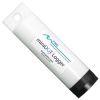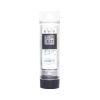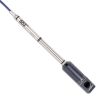HOBO Dissolved Oxygen Logger
Features
- Affordable, high performance dissolved oxygen (DO) monitoring with 0.2 mg/L accuracy
- Optical DO sensor technology for long-lasting calibration with less maintenance
- Requires HOBOware Pro Software and optic base station or waterproof shuttle
- Free ground shipping
- Expedited repair and warranty service
- Lifetime technical support
- More
Overview
The HOBO U26 Dissolved Oxygen Logger measures and records oxygen concentrations in lakes, streams, rivers, estuaries, and coastal waters. The affordable and precise HOBO U26 data logger is recommended for aquatic biology and hydrology research projects. The U26 Dissolved Oxygen Logger is the ideal tool for environmental impact studies as well as ecological and oceanographic research in freshwater and saltwater environments.
Rugged Dissolved Oxygen Technology
The HOBO Dissolved Oxygen logger is a standalone logger that uses RDO Basic Technology to measure dissolved oxygen (DO). The logger has an optical sensor that provides 0.2 mg/L accuracy. The logger also features an easily replaceable sensor cap and an integrated temperature sensor. Using the data offloaded from the HOBO U26 logger, the HOBOware Dissolved Oxygen Assistant can calculate percent saturation and salinity-adjusted DO concentration as well as correct for measurement drift from fouling (additional meter or logger measurements required).
| Dissolved Oxygen | ||
| Sensor Type: | Optical | |
| Measurement Range: | 0 to 30 mg/L | |
| Calibrated Range: | 0 to 20 mg/L; 0 to 35°C (32 to 95°F) | |
| Accuracy: | ± 0.2 mg/L up to 8 mg/L; ± 0.5 mg/L from 8 to 20 mg/L | |
| Resolution: | 0.02 mg/L | |
| Response Time: | To 90% in less than 2 minutes | |
| DO Sensor Cap Life: | 6 months, cap expires 7 months after initialization | |
| Temperature | ||
| Temperature Measurement/Operating Range: | -5 to 40°C (23 to 104°F); non-Freezing | |
| Temperature Accuracy: | 0.2°C (0.36°F) | |
| Temperature Resolution: | 0.02°C (0.04°F) | |
| Response Time: | To 90% in less than 30 minutes | |
| Logger | ||
| Memory: | 21,700 sets of DO and temperature measurements (64 KB total memory) | |
| Logging Rate: | 1 minute to 18 hours | |
| Time Accuracy: | ±1 minute per month at 0 to 50°C (32 to 122°F) | |
| Battery: | 3.6 V lithium battery; factory replaceable | |
| Battery Life: | 3 years (at 5 minute logging) | |
| Download Type: | Optical | |
| Depth Rating: | 100 m (328 ft) | |
| Buoyancy: | Salt water: 13 g (0.46 oz) negative | Fresh water: 20 g (0.71 oz) negative | |
| Wetted Materials: | Black Delrin®, PVC, EPDM o-rings, silicone bronze screws; rated for saltwater use | |
| Size: | 39.6 mm diameter x 266.7 mm length (1.56 x 10.5 inches) | |
| Weight: | 272.4 g (9.61 oz) | |
| Environmental Rating: | IP68 | |
- HOBO U26-001 Dissolved Oxygen Data Logger
- Dissolved oxygen sensor cap
- Protective guard
- Calibration boot and sponge
In The News
From Paddles to Phytoplankton: Studying Vermont’s Wildest Lakes
For six months of the year, Rachel Cray, a third-year PhD student at the Vermont Limnology Laboratory at the University of Vermont, lives between a microscope and her laptop, running data. For the other six months, she is hiking and canoeing four of Vermont’s lakes, collecting bi-weekly water samples. Cray studies algal phenology across four lakes in Vermont, US, that have low anthropogenic stress—or in other words, are very remote. Funded by the National Science Foundation Career Award to Dr. Mindy Morales, the lakes Cray researches part of the Vermont Sentinel Lakes Program, which studies 13 lakes in the area and, in turn, feeds into the Regional Monitoring Network, which operates in the Northeast and Midwest US.
Read MoreReimagining Water Filtration: How Monitoring and Science Enhance FloWater Filtration Systems
Over 50% of Americans think their tap water is unsafe , according to the Environmental Working Group (EWG). Other recent surveys have found that number to be as high as 70% of persons surveyed. Whether due to increased public awareness of water quality issues or confusion about how municipal water sources are regulated, there is a clear distrust of tap water in the United States. According to industry expert Rich Razgaitis, CEO and co-founder of the water purification company FloWater, this issue creates a damaging cycle. Razgaitis explained that the health and environmental problems associated with contaminated water aren’t the only issues. As people become increasingly aware that some tap water is unsafe, they resort to bottled water.
Read MoreMonitoring New Hampshire’s Aquatic Ecosystems: Continuous Data Collection in the Lamprey River Watershed
New Hampshire’s aquatic ecosystems provide a range of ecosystem services to the state and region. Resources and services like clean water, carbon storage, climate regulation, nutrient regulation, and opportunities for recreation all depend on New Hampshire’s aquatic ecosystems remaining healthy. Jody Potter, an analytical instrumentation scientist at the University of New Hampshire (UNH), is studying these aquatic ecosystems in hopes of developing an improved understanding of ecosystem services and their interactions with climate change, climate variability, and land use changes. [caption id="attachment_39799" align="alignnone" width="940"] Aquatic sensors in the Merrimack River in Bedford, NH, with I-293 in the background.
Read More
















